A Crash Course in Space Junk
There is a floating museum above our heads: millions of fragments from past space missions are hurtling round the earth and could destroy our current satellites. We find out how spacecraft are coping now, and how we might be able to clean up space in the future. Plus, news of a synthetically engineered yeast genome, a breakthrough in OCD and a new ebola vaccine for gorillas.
In this episode

00:51 - Synthetic yeast genome brings us closer to artificial life
Synthetic yeast genome brings us closer to artificial life
with Jef Boeke, from the NYU Langone Medical Center in New York
Scientists have announced that they have successfully engineered from scratch a significant part of the DNA genome of yeast. The team have now made synthetic forms of 6 of yeast’s 16 chromosomes, which are the DNA hubs inside cells where genes are located. Inserted into yeast cells in place of the native chromosomes, these synthetic forms “booted up” and worked normally. This, researchers say, brings us closer to the goal of producing completely synthetic life. New York-based scientist Jef Boeke is leading the project, and he spoke to Chris Smith…
Jef - The papers that came out in Science this week describe the complete design of a synthetic version of the yeast genome, and that would be the yeast commonly used to brew beer and bake bread. It’s also a very important organism for basic science research and we’re announcing that five additional chromosomes have been synthesised to this design. They are alive and well inside a yeast cell and powering the normal growth of such a yeast cell.
Chris - Talk me through how you did that and for what reason?
Jef - We started with the genome spread out on a computer screen essentially. We wrote computer code to assist us in making systematic alterations to the genome sequence. To give you an example of how extensive that can be, something like one sixth of the bases or letters in the genome were either removed, altered, or replaced by a different sequence. So it’s really like a very heavily edited manuscript if you will. In fact, we sometimes jokingly refer to the computer code that we used to do this as “track changes for genomes,” if you’re familiar with the Microsoft word application.
After that is done the designed sequence is chopped up into very small bits of 100 DNA letters that can be synthesised on a machine, and there are many companies out there that make these small DNA’s referred to a oligonucleotides. Then these short snippets of DNA are strung together into ever larger pieces of DNA.
Then the final stage is that pieces of 60,000 DNA letters, or so, are mixed together with a yeast cell and they go and swap themselves into the chromosome, and remove the native material that’s there until the entire chromosome is replaced. The native DNA has gone and the synthetic DNA is there in its place.
Chris - So just to orientate people - when we’re talking about a chromosome, this is a molecule of DNA that has, potentially, thousands of genes in it, and those genes are made of individual letters of DNA. You have edited the DNA sequence in a computer, made an artificial form, assembled it, and then swapped in your assembled forms to replace those original DNA codes in the yeast chromosomes. So you end up, ultimately, with the yeast cell that have these artificial edited genomes working in them rather than their native original wild type genome.
Jef - I couldn’t have said it better myself.
Chris - But why - that’s the question? What’s the point of doing this and what does this prove, the fact that these cells can be booted up in this way and they’re running, they’re operating? What does that show us?
Jef - It shows us many things. One of the things that we’ve learned is that we can do remarkable things to the structure of those chromosomes. We can rearrange them in ways that haven't been seen in nature and the yeast seems to be not upset about these alterations and continues to grow very well despite the fact that we’ve moved huge chunks from one chromosome to another chromosome, for example.
Chris - Given the similarity between yeast cells and our own cells, would this in theory then, be possible to do with a human cell?
Jef - Yes, this would be possible, in principle, with any cell type from any organism. And some of my colleagues here in New York, and in other parts of the world, are very interested in engineering human cells to contain a synthetic genome, or synthetic chromosomes. We see many possible therapeutic benefits coming from this type of research. We could make systematic alterations to the genetic code in the human cells that would render those cells unable to be infected by a virus. This is based on work that was started in a colleague’s lab, George Church at Harvard.
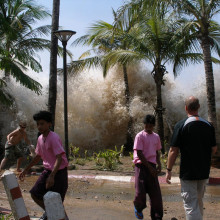
06:17 - New earthquake model could protect people from natural disasters
New earthquake model could protect people from natural disasters
with Crescenzo Petrone, University College London
Six years ago a tsunami hit Japan killing 15,000 people and triggered a nuclear disaster at the Fukushima power station. This was caused by an offshore mega subduction earthquake (where one tectonic plate is forced beneath another), which can cause unpredictable and deadly chains of events. Now, a project called CRUST (Cascading Risk and Uncertainty Assessment of Earthquake Shaking and Tsunami) have developed a system which could help us make better predictions about the consequences of undersea earthquakes like the one that hit Japan. Kat Arney spoke to CRUST team member and earthquake specialist Dr Crescenzo Petrone, from University College London to find out about the project...
Crescenzo - CRUST is a joint effort between the University of Bristol, University College London, and also supported by a testing facility at HR Wallingford. It’s mainly looking at developing a computer model for the assessment of a chain of events which are triggered by these subduction earthquake, such as earthquake, tsunami, landslides and series of aftershocks. This is the first time where a unique platform is employed to gather together a lot of different hazards which are particularly modeled on their own, so without an analytic approach.
Kat - So you might just look at an earthquake or a tsunami separately and not bringing them all together?
Crescenzo - Yes. So you might assess the damage on the build environment caused by earthquake only, tsunami only, or landslide only. Whereas this one is capable of getting a unique result out of the study.
Kat - All kinds of disaster basically. So this isn’t a prediction thing; this isn’t red lights flashing, a tsunamis coming, you’ve got to get out of the area. That’s not what we’re talking about here?
Crescenzo - No. This is a tool to be used in peacetime. It’s mainly used to help policymakers to mitigate the risk by employing proper emergency evacuation. Also I mentioned planning, designing buildings against these threats, and the insurance sector in assessing economic losses associated to these kind of events.
Kat - Because we do know now where in the world is susceptible to earthquakes and tsunamis. We know where the fault lines are that are cracking the surface of our earth. So you’re saying that this model will enable people in those areas to go OK, what are we at risk of, how should we take appropriate action to defend ourselves?
Crescenzo - Yes, yes, definitely. So policy makers might decide where to place a tsunami evacuation building where all the people should gather in case of tsunami alert that will be triggered. They will decide where to put schools, hospitals and sensitive kinds of buildings. This will interest not only the pacific belt like Japan, New Zealand, California and Chile, but also Europe. As you might recall, in the 18th century a tsunami impacted Lisbon and, more recently, at the beginning of 20th century a tsunami also occurred in Southern Italy. So it’s closer than we might think of.
Kat - How do you get the data to put into this model because in any model you need data from the real world, you put it into the computer, and it kind of says this sort of thing might happen? Tell me about the model and the facility where you’re studying this and getting data?
Crescenzo - Part of the study is looking at how the built environment responds in case of a tsunami and earthquake occurs. In this project we are using a unique, world leading facility at HR Wallingford in the UK, which is able to simulate a tsunami in a flume. In particular, we are looking at what’s the impact of a tsunami on a multiple cluster of buildings, also taking into account the presence of coastal defences, which brutally failed during the Japan event.
Kat - What I’m imagining here is almost like a model village. I’ve been to a model village. Is this what you’ve got, you’ve got basically a model village in an enormous tank of water and you spend all day just smashing it up?
Crescenzo - Yes, almost. Simply speaking yes, it’s like that. It’s a water tank that pumps some water and sucks some water so the water retrieves from the shore, and then the water inundates the idealised group of buildings which we’ve set up in Wallingford. We assess what’s the force on the building and what’s the influence of the building arrangement on the force acting on these kinds of buildings.
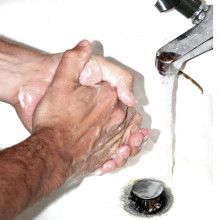
11:40 - OCD sufferers fail to learn when something is safe
OCD sufferers fail to learn when something is safe
with Annemieke Apergis-Schoute, Cambridge University,
OCD or excessive compulsive disorder affects about one person in 50. Patients with the condition often feel compelled by anxiety to perform repetitive, ritualistic behaviours, like washing their hands a certain number of times or getting dressed in a certain way. If they don’t comply, they experience an overwhelming sense of dread that something terrible will happen. One way to treat the problem is to prevent sufferers from fulfilling their rituals - for instance, making them touch a toilet seat and then stopping them from washing their hands more than once. But this only works for about half of patients, so what’s needed is a deeper understanding of what causes OCD in the first place so that better therapies can be developed. Now Annemieke Apergis-Schoute, at Cambridge University, has discovered that OCD patients are very good at learning when things are unsafe or a threat, but they fail to be flexible and learn when something is actually safe, as she explained to Chris Smith...
Annemieke - We used an experiment where you had one threatening stimulus. That meant it was a stimulus that was sometimes paired with a mild electric shock, and another stimulus that was always safe, so it was never paired with a shock. The nice thing about this experiment is that we can measure very small changes in sweat in the skin so we know exactly when the participant is expecting a shock and when they are not, because you see a difference in the amount of sweat that comes on. And then unannounced in the middle of this experiment, the threatening stimulus became the safe one, and the safe one became the threatening one.
Chris - Right. So let’s say, for the sake of argument, I show them a picture of an orange and I give them an electric shock whenever they see it. I show them a picture of an apple and I never give them an electric shock. So you’re measuring how much they sweat when I’m presenting this sequence of pictures at them randomly and then, all of a sudden, you flip round so the orange, which was I’m going to get a shock now becomes no shock, and the apple, which was safe now gets an electric shock?
Annemieke - Exactly.
Chris - If a person who is not affected by OCD does this, what do you see in a normal person first?
Annemieke - What we see there is that they’re very flexible. They have increased amounts of sweat, which we call skin conductance, to the threatening stimulus compared to the safe stimulus. And then when this reverses, so when the threatening one becomes safe and the safe one becomes threatening, they very easily adapt to this. So that in a few trials, the one that has now become threatening, which was previously safe, leads to more sweat than the newly safe one.
Chris - Right, and what happens when you do the same thing with someone who has got OCD?
Annemieke - What we found in this study is that although they initially learn that one of the stimuli is threatening, when this changes they can’t learn that stimulus that was previously threatening is now safe.
Chris - If one looks at the brain when it is in the process of doing this reversal, when you take something that was a threat that had something unpleasant attached to it and you flip it round and make it un-nasty, how does it compare when you look at someone who’s normal and someone who’s got OCD?
Annemieke - Because we performed this experiment while the participants were in the brain scanner, an area called the ventral medial prefrontal cortex that we know is specifically involved with learning safety of stimuli, and we already know that this area gives a larger signal to when a stimulus is safe. What we found was that this signal was entirely absent in OCD patients from the get go, meaning they did the initial learning based on just learning about the threatening stimulus in absence of learning most likely about the safe stimulus.
Chris - Is it that there’s physically some kind of circuitry missing that enables them ascrib safety to things, or is it that they’re just very good at rendering things unsafe?
Annemieke - I have my own theory about this. I believe that this area of the brain might be too concerned with their kind of self-referential kind of thinking about their own obsessions and, perhaps, unavailable to pay attention when things are rewarding or safe in the environment.
Chris - Does this help that 40 percent or so of people for whom the exposure therapy does not work at the moment? Have we got some clues on the basis of what you’ve found as ways we can intervene more meaningfully for those people?
Annemieke - So, yeah. We think that we can come up now with new therapies. For example, in terms of the exposure with response prevention therapy, we could augment a therapy by enhancing the experience of the safety. So when they actually touch the toilet seat that they feel more of a reward, that they feel oh yes indeed, nothing went terribly wrong when I didn’t wash my hands right afterwards. So this experience can be more meaningful and, perhaps, is easier for them afterwards to overcome the urge of performing the compulsion.
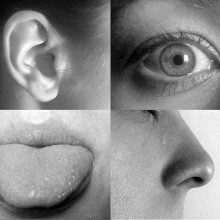
17:17 - Myth: You have five senses
Myth: You have five senses
with Kat Arney
For this week's mythconception, Kat Arney has been sniffing out the truth about our senses.
Kat - Even a child knows that we have five senses: touch, smell, sight, taste and - of course, for fans of the Naked Scientists - hearing. Together, they enable us to perceive the world around us and - literally - make sense of reality.
The Merriam-Webster dictionary defines ‘sense’ (in this context) as “a specialized function or mechanism (as sight, hearing, smell, taste, or touch) by which an animal receives and responds to external or internal stimuli”. But it might surprise you to know that the textbook idea of five senses is actually a myth.
The latest scientific research suggests that we have far more than five senses, and maybe as many as 33 in total, or even hundreds more. Alternatively, a reductionist approach could knock those five down to just three. So, where did the idea of five senses come from, and what are all these other senses that we have? Let’s listen and learn…
The idea of the Big Five, as I’ll call them, probably dates back to Aristotle and his book De Anima, or On the Soul, where he explains the classic five senses of smell, taste, touch, vision and hearing. And since then, this sensory quintet has been the starting point for pretty much every sensory discussion from science to philosophy.
As scientists learned more about the nervous system and the inputs that go into it, the total number of senses went up to nine - namely the famous five plus pain, mechanoreception (that’s balance and direction), temperature, and so-called interoreceptors, which measure things like blood pressure or how stretched your bladder is (meaning that it’s time to take a trip to the loo!)
The latest research suggests we have at least 21 senses, and some researchers put that number up at around 33 - notably a large science and humanities research project called Rethinking the Senses.
The list includes: Smell, taste, low light vision (rod cells in the eye), colour vision (that’s cone cells), sound, pressure, heat, cold, itch, proprioception (where bits of your body are in space), tension (such as in muscles and tendons), stretch (bladder, lungs and things like that), pain, balance (or equilibrioception), thirst, hunger, and chemicals in the blood such as hormones.
Then there’s magnetoception - the ability to detect magnetic fields. This is very weak in humans, but does seem to be there. And then there’s the ability to accurately sense time passing, which is more hotly debated but does seem to go awry in people with neurological disorders.
Then there is the question of when to stop counting senses. Do we count each type of taste receptor? That’s sweet, salt, sour and umami. And what about the weird effects of sichuan peppercorns, which actually cause vibration-like stimulation of a facial nerve. And should we count all the thousands of individual odorant receptors in the nose as individual senses? After all, they all pick up different smelly chemicals.
Added to this is also the discovery that some people have senses that others don’t. For example, some people can learn to ‘see in the dark’ using echolocation, making clicks with their tongue and listening to how the sound bounces off the walls around them.
And if you want to get really reductionist about it all, you could argue that humans have just three senses, based on the kind of input coming into the nervous system - mechanical senses that measure physical changes (which would include touch, hearing and proprioception), light detection, and chemical sensing, which takes in taste, smell and all the sensory inputs that come from chemical signals within the body.
Before we start suffering from a sensory overload, let’s take a step back. In fact, the bigger question is not exactly how many senses we have, but how our brains integrate all the information coming in from our bodies to build up a picture of the world around us. The exact number doesn’t really matter - it’s what we do with the information that counts.
Finally, there’s the spooky question of whether we really have a so-called ‘sixth sense’ that enables us to sense magical or paranormal weirdness? Sadly not. A study in 2014 by Australian researchers debunked the idea that some people can somehow sense changes that they can’t identify. And many researchers have shown that claims of extra-sensory perception or sixth sense just don’t hold up under scientific scrutiny.
Rather than any unusual senses, these phenomena are either due to natural, rational explanations, tricks, or are the work of that wonderful human organ - an overactive imagination.
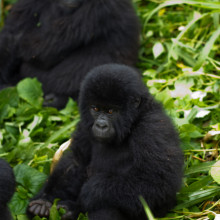
21:20 - Have we lost the chance to save our gorillas?
Have we lost the chance to save our gorillas?
with Peter Walsh, University of Cambridge
Ebola made the headlines in 2014 when there was major outbreak in West Africa. Thankfully, for the time being at least, the threat to humans was halted, but it’s still a massive problem for gorillas. Experts estimate that, over the last 30 years, a THIRD of gorillas have been wiped out by the virus. So how do you protect a wild animal from a disease? The same way you do with people: a vaccine! The results from a trial in chimpanzees for a new oral vaccine were published this week in Scientific reports, suggesting the vaccine would be effective, with no damaging side effects. But new legislation in America could prevent further trials of this kind, which could be devastating for future outbreaks of diseases in our endangered cousins. Georgia Mills spoke to Peter Walsh from the University of Cambridge, and Apes Incorporated, about the challenges of vaccinating a 450 pound wild gorilla!
Peter - With wild animals it’s more difficult to protect them. Some of the gorillas and chimpanzees are in tourism programmes or research programmes where they’re habituated to the presence of people. With those animals you can get up close, you can get a dart gun or a blow dart. We use a phtt and you can shoot them with a little dart that has the vaccine.
The other animals are very afraid of people and so it’s too difficult to try and track each one and shoot them with a dart. So what we’re working on is an oral vaccine where you put the vaccine in a little bait. We’re using a fruity bait that’s sweet and we’re testing that now Africa. You put the vaccine in there and then you can put that at areas where there’s high activity rates by gorillas and chimpanzees, and then they’ll eat the bait and then become immunised that way. We have a problem right now, we have gambian rats (pouch rats) and the rats come in at night and they eat all my bait and so I’m working on ways to get around that. But, in principle, we should have the ability to really precisely target who gets vaccinated.
Georgia - OK. I suppose you’ve got to test that this form works?
Peter - Exactly. So we need to go out and, preferably, in the species that we’re trying to vaccinate in the wild, we need to test in the captive animal or closely related species. So chimpanzees, gorillas, and humans also, are very closely related. The objective of testing this in a chimp is to see will it have a robust immune response and will it cause any kind of health complications, and so the trial we’ve just done did exactly that. We took ten chimpanzees: four of them we injected intramuscularly and six we gave an oral dose of the vaccine. Then we took blood samples every week for a month and what we found was, first of all, it didn’t cause any health complications, they didn’t get sick. And they didn’t show any kind of behavioural anomalies, they weren’t really stressed out.
And the other thing it showed is they had an immune response that was very similar to the immune response of monkeys who were vaccinated, and then challenged with ebola and survived. So we didn’t actually challenge the chimps with ebola, we just look at their immune response and health response, but their immune response was very similar to the responses of these monkeys that were actually challenged and survived challenge.
Georgia - Is it quite hard to test these things? I mean, there aren’t too many gorillas and chimps around - is it hard to get that testing process through?
Peter - Yes. It’s exceptionally hard because the United States is the last developed country that allowed biomedical testing on chimps and, as of last summer, they’ve now banned it. The rationale was that it was inhumane and that it was unproductive scientifically. I don’t want to get into a debate about whether or not it was productive for human health, that’s somebody else’s business. But what I can tell you absolutely is a) that it’s not unproductive for conservation reasons, and b) we actually did monitor the stress responses of the chimpanzees during the trial, and they don’t show the extreme health effects that the animal welfare advocates were claiming. So now they’ve shut down these facilities and we really have no place where we can do the trial.
Now what critics say was: you can do this in a sanctuary, you could do this in a zoo. While the sanctuaries are all philosophically opposed to animal testing so they won’t do it, but zoos have facilities to do it safely. That’s the other issue as well - where can you do this safely? But they are terrified of a public backlash. So here we are, we have really no place where we can do these trials and consequently that’s a problem because in Africa, they say if you haven’t tested that vaccine in a captive ape, or any human, you're not going to use it on our endangered apes in the wild. So it’s a catch 22.
Georgia - Right. So in future when the next ebola comes it’s going to be more difficult to do what you’ve done here?
Peter - Exactly. This has happened before. Ebola goes away for a while and people say oh, it’s gone, it’s not a problem anymore, and then ‘boom’ it comes back and it kills a bunch of people. And all of a sudden it’s in the news and it’s like “Oh, we’re going to worry about it again,”. For once, for once, why don’t we think into the future and not react on a crisis basis but actually plan ahead and say you know a) we’re going to need to vaccinate for ebola again in the future, and b) there’s always other diseases. These animals are critically endangered. They’re in really bad shape and it’s incredibly frustrating because we have the ability to protect these animals but we’re not doing it for silly, foolish reasons.
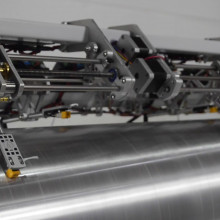
27:03 - The sounds of space junk
The sounds of space junk
with Cath Le Couter and Nick Ryan, Project Adrift
Thousands of pieces of space junk are in orbit around the earth right now, silently hurtling through space. Project Adrift are a pair of artists, Cath Le Couter and Nick Ryan, who have attempted to give a voice to these bits of junk, with videos, social media and even music. Cath Le Couter explained why...
"Guys - I’ve got to tell you, I think my spatula has escaped."
Cath - I was researching another project and I came across this story of an astronaut (Piers Sellers) dropping has spatula in space in 2006 and it became a bit of space junk careening around the Earth at seventeen and half thousand miles per hour. And I found this image just really provocative, a very mundane kitchen instrument hurtling around the Earth and that image made me think "wow, what is this space debris?".
So I read up a little bit more and discovered in 1965 that another astronaut had dropped his glove in space and that too, for me, was just a very, very strong image. Quite a sad image you know, a glove, just orbiting around the Earth on its own.
I guess that’s what initially made me interested and curious about what was this world of space debris that I knew nothing about. And pretty quickly after that I discovered that it represented this very significant crisis and that there was actually a hundred million bits of junk circling our Earth.
When I first started discussing this hidden world with Nick Ryan, who's a sound artist, Nick was instantly fascinated with how this space junk was silent and how could he give voice to this junk? So he developed an electromechanical instrument that’s about one and a half metres long, it’s made of aluminium, and it turns, and into this long aluminium cylinder are a thousand grooves of sound. And every time a bit of space junk flies above where the instrument is, a little stylus hooks into one of those grooves and plays a sound.
The different sounds depends on the size of the junk and that will determine the kind of tone that you’re hearing. So a very small bit of junk has a very high pitch, and some of the really enormous bits of junk - there’s a piece of space junk called Envisat that’s the size of a London bus - and if a very big bit of junk passes overhead then you hear a very deep tone.
The potential of this space junk is so incredibly destructive and yet some of it is extraordinarily beautiful, and some of it has the most wonderful stories behind them. A lot of the junk that’s up there, early satellites that were part of the very, very beginning of the space race in the early 50s. It’s like there’s a floating museum of our past space exploration travelling above us but, at the same time, these beautiful items in many ways are now threatening to destroy us.
We commissioned several fantastic writers to write the characters of the three bits of space junk we were most interested in and they wrote stories that were true for those bits of space junk, and developed personalities for those bits of junk. So Vanguard was the first solar powered satellite into space, the oldest bit of space junk ever. So it’s a very heroic, proud piece of space junk but it’s now starting to question its purpose in life. So it’s a bit depressive.
Suitsat is an old Russian spacesuit that was pushed out of the International Space Station in 2007 and it was fitted with a transmitter for real. It was meant to communicate with us on Earth but it failed, became a bit of space junk, and it burnt up in the Earth’s atmosphere. So for the purposes of Project Adrift, suitsat is a ghost and it’s travelling the exact path that it took when it was first pushed out of the station.
And Fengyun... Fengyun was born out of a very violent, deliberate explosion in space. The Chinese sent up a missile to blow up an old weather station and they blew it into 3,000 pieces, and it was the worst space debris event of all time.
"My name is suitsat. Alone in space I spiral around anything, making shapes in the nothing, cutting a line through nothing. But in the nothing: more and more sparkling things appear. Not stars: space junk. All this junk was flying past me at 17,000 miles per hour. This was what I was meant to speak about. All it could take is one more collision up here and future space exploration will become impossible."
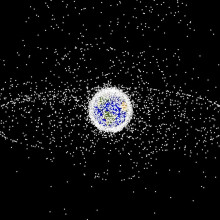
33:44 - What is space debris?
What is space debris?
with Hugh Lewis, University of Southampton
Why is space junk a threat to us? And how come there’s so much of it up there? Kat Arney talks to extraterrestrial rubbish expert Dr Hugh Lewis from the University of Southampton.
Hugh - We’ve been launching satellites into orbit since the late 1950s, so we’ve basically accumulated a lot of junk associated with all those space launches. They can be satellites that have reached the end of their mission. It could be the parts of the rocket that we’ve used to put the satellites there. It could be bits and pieces from those satellites that have somehow come away. But the most numerous objects up there are fragments from explosions and collisions.
Kat - It’s big bits and it’s small bits. But why is it so much of a problem? Doesn't it all eventually just fall back down to Earth?
Hugh - Well actually, many of the objects that are up there will be up there for centuries or even longer and that’s simply because the only mechanism we’ve got for removing the objects from the orbit is the atmosphere at the moment, and the atmosphere is so sparse at those altitudes.
Kat - So thinks aren’t just breaking down and burning up?
Hugh - No, absolutely. So yes, if an object is experiencing enough atmospheric drag it will come down and burn up. But objects that are high enough don't experience that kind of drag and they can be there for… some of the objects - Cath mentioned Envisat in her piece there - and that’s potentially up there for more than a hundred years.
Kat - Now isn’t space massive? We shouldn’t forget that space is enormous so how come this junk poses a problem for other things we want to send up into space?
Hugh - Well I think that the space is big mantra was used and has been used since the beginning of the space age and it’s certainly true. The volume space occupies is enormous. But what we’re doing is sending satellites into quite specific orbits and into orbits that are relatively close to the Earth. And if we keep doing that, as we’ve been doing for the last 50/60 years, then all that junk accumulates relatively close to the Earth in these quite congested orbits.
Kat - The way I like to think about is it’s like a trail of muck going from your front door where you always walk across the same bit of the carpet.
Hugh - Yes, absolutely right. Yes, that’s a very good analogy.
Kat - We saw in the film Gravity, there’s a collision with some space junk and it sets off a massive chain reaction. Is that the worse case scenario that there could be a rocket going up, or a really important communications satellite or something and it gets knocked out?
Hugh - Yes. So, fundamentally, the problem with space debris will be those collisions that could occur. You could lose a satellite from an impact with something in orbit. But that collision cascade that you talk about is, I guess you could say, that’s the absolute worst case that you could expect. That’s something that we’re working very hard to try and avoid.
Kat - There was in the news recently that the Chinese have, apparently, lost control of an abandoned space station that was up there so, presumably, this is now classed as space junk? That’s quite a big thing and what’s going to happen to it up there?
Hugh - That particular space station, I guess, it’s not as big as the International Space Station. It’s slowly moving down in terms of altitude and will ultimately, we hope, burn up in the atmosphere.
Kat - But what if it doesn’t, is it going to come down? And do these bits of junk actually come down and hit the Earth?
Hugh - It is possible for parts of spacecraft to survive that re-entry process; the heating and the loading that they experience, so some components may survive down to the surface of the Earth. But most of the Earth (three quarters of the Earth) is covered by water so it’s quite likely that we’d never even see these objects as they come in.
Kat - We also heard in Cath’s piece that there’s a whole load of debris from the Chinese trying to blow up something to try and get rid of it, and that’s just made the problem worse. Is it the big bits of debris or the small bits that are the most concerning?
Hugh - I think, in terms of the long term evolution of the space environment, we worry about the big objects because, essentially, all that mass that is locked into that object can be converted into many, many fragments. But in terms of objects that can be lethal, you’re talking about objects that are probably the order of millimetres in size that can actually pose serious risk to operational spacecraft.
Kat - That seems pretty dramatic when you think oh, it’s just going to be something massive and, in fact, it could be almost a fragment of dust something the size of a piece of sand that could bring down your spaceship?
Hugh - Yes, indeed. The space shuttle, when that was flying, they would have to replace the windows on the space shuttle, for example, due to the impacts that they would receive from objects that were very, very small. The craters that were left behind there are just perfect evidence of the risk that space debris poses.
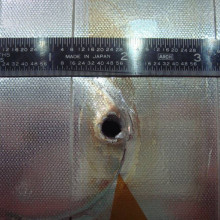
39:13 - Why is space junk a problem?
Why is space junk a problem?
with Tim Flohrer, European Space Agency
There's lots of space junk flying around in Earth's orbit, but how is this affecting our current exploits in space? Tim Flohrer, a Space Debris Analyst from the European Space Agency, spoke to Chris Smith.
Tim - You have to distinguish two things. We are operating our spacecraft so it’s part of our daily business to deal with the space debris that is up there. Secondly, of course, we are planning technologies to bring back these large objects that you are talking about. So it’s something we care about more in the future if you like.
Chris - So there’s both the worrying about where it is, and then worrying about making sure it doesn’t hit your spacecraft? So let’s unpick that a bit then and tell us how do you track these objects? How are you keeping an eye on where the things are?
Tim - There’s something that is called a catalogue of all the elements. So you can imagine it’s like the precisions and velocities of these debris objects down to about ten centimetres or a bit smaller. That is available from sensors on the ground and in space and basically it comes from the U.S from sensors that the U.S. is running. So these are radar sensors and also telescopes. The radars cover the lower altitudes, the lower orbits and the optical sensors more the higher altitudes.
Chris - So you build up a profile of what’s up where, basically, so you know what’s where and how big it is, and how fast it’s moving, and where it’s going?
Tim - Exactly. And from that we can calculate the risk that it is to be at the same position at the same time, you name it a collision.
Chris - OK. Once you’ve tracked something, say you want to put a spacecraft in a certain position, or go from A to B, and you now there are some of these objects around. How do you make sure that your spacecraft doesn’t get hit by them?
Tim - As you said, we are predicting the positions of these debris objects and we know where our object is and, if the risk is too high, then we do something that we call “collision avoidance.” So we move away our spacecraft and make it out of the way of the debris object, and then move it back after the close approach has passed.
Chris - Is there a financial cost to this? I presume there must be if you have to move things around then you’re using fuel, you’re using time, you’re maybe moving things out of service? So is there an impact on people’s pockets through having to do this?
Tim - You’re absolutely right. Being the European Space Agency, we can’t do science in that timeframe where the satellite is not where it’s supposed to be. So, for us, it’s mainly losing the value of the time for acquiring the science data. But for commercial operators it means that they can’t do business during that short timeframe but it’s a short time that they can’t do their business.
Chris - With an eye on the future, are you future proofing or has anyone put in place a policy now so that when we send things up there, we’ve got an end of life idea what’s going to happen to it? How we either retrieve it or stop it breaking up to contribute to the problem and make the problem worse?
Tim - There are two things. One is we call it “mitigation of space debris” and this covers these aspects like passivate your spacecraft at end of life, so make sure it can’t explode or fragment. So remove the fuel, shortcut the batteries, and those things. The second thing is to move it into an orbital regime that’s not in a protected regime and also to limit the time in orbit. That is very important and has been moved into standards and into guidelines and, in some countries, even into law but this is an ongoing process. The standards are there, the guidelines are developing and the law and regulations widely has to come still.
Chris - But if the Chinese decide they’re going to blow up another satellite tomorrow, is there anything that can stop them?
Tim - Well, political pressure of course can stop this. But if they have the technology then it’s something they can do, but I’m pretty sure they won’t do that.
Chris - So they’ve learned their lesson is what you’re saying?
Tim - I think so. Because they are operating in the same orbit as all the others so also their satellites have to move away from the debris they created with this event in the past.
Chris - What about the things that we’re working on right now? Things like the International Space Station because that’s huge. Is there an end of life plan for that to retrieve that safely so it doesn’t contribute to the debris up there?
Tim - First of all we hope that the International Space Station is still there for a few more years, but actually we are looking into this already how to bring it down. But this is a few years to go still.
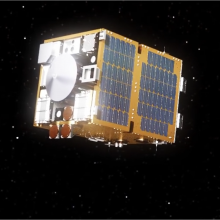
RemoveDEBRIS: How to clean up space
with Aaron Knoll, Surrey Space Centre
Space junk is currently a problem and could be an even bigger problem in the future, so the big question is - can we clean up space? There are a few projects worldwide looking into this and one is at Surrey Space Centre, where removeDEBRIS is going to test several technologies for bringing this junk back down to Earth. Aaron Knoll is a researcher at Surrey Space Centre, and Georgia Mills asked him why it’s so tricky to fix this messy problem.
Aaron - It’s a challenge because pieces of space debris are one in space so they’re quite a way away from the surface of the Earth, but the other reason is that they’re moving incredibly fast. So they’re moving on the order of about 7 kilometres every second so actually rendezvousing with a piece of space debri, in and of itself, is an extraordinary challenge, let alone trying to get rid of it.
Georgia - What is Surrey Space Centre trying to do about this?
Aaron - We have a project called “remove debris”, which is aiming to demonstrate technologies for rendezvousing with an uncooperative object (that's a piece of space junk) and then testing various technologies to actually tether or secure ourselves to the object and then, finally, to tow the object out of orbit.
Georgia - So what kinds of things is it going to try and do?
Aaron - It has a couple of different technologies it’s testing in orbit. The first is a harpoon, which sounds rather primitive in technology and, indeed, you can say it is. But what it is is it’s a sharp metal object that penetrates the surface of, let's say, an old dysfunctional satellite and then with barbs it actually hooks onto the surface of that satellite. You have a tether connecting the harpoon to the main mother ship, and then that mother ship can pull it out of orbit.
Georgia - I assume that’s for the larger pieces, what about the smaller ones?
Aaron - We’re also testing something called “net capture”. So we deploy a large net which ensnares smaller objects and, as well as with the harpoon, once you’ve ensnared those objects you would use a tether to drag them out of orbit.
Georgia - I like the way it’s a harpoon and a fishing net that you’ve got here. Cleaning up space junk is basically fishing?
Aaron - Yes. I’ll say the actual technologies were selected based on their reliability. You don’t want to have pieces of technology which are complicated just purely for the sake of being complicated. You want to actually balance what you’re trying to do against the most convenient way of doing it, and it turns out that the net and the harpoon were actually coming up on top in terms of their simplicity and their reliability.
Georgia - Once you harpoon or you net a piece of space junk, how do you get it back to Earth?
Aaron - Once we’ve secured them, we’re testing a de-orbiting sail. This is a 5 x 5 metre sail and it puts a large drag surface area onto the spacecraft so that even the small amount of atmosphere, which is in orbit, will slowly pull the spacecraft on a descending trajectory, and it will burn up in a ball of fire in the Earth’s atmosphere.
Georgia - So where are we with this plan - what’s next?
Aaron - We’ve come a long way on actually developing the technology, so the next phase is to launch it into orbit. I believe that we’ll be launching in the next year or two and then we’ll be able to see whether these technologies actually work.
Georgia - Oh wow! Is the plan in the long run for this technology, is the mother ship going to go along grabbing loads of different bits of space debris? Or is that not possible and will it just have to get one and fall back to Earth because that seems an incredibly expensive way of cleaning up space?
Aaron - So, the long term objectives I think what you’ll see is a mother ship that’s able to rendezvous with multiple objects and then attach to themselves a rocket motor to drag them out of orbit. But then again, it could rendezvous with another object, so then you could have one mission cleaning up multiple pieces of space debris.
Georgia - These are the projects the Space Centre’s working on. Are there any other zany ideas or wacky plans people have come up with to try and sort this problem out?
Aaron - Yes. I’ve heard of a number of different projects. The one that I find particularly interesting is called the “ion beam shepherd.” As opposed to actually securing to the object with a tether and then trying to drag it out of space, this one aims to use an ion beam from a spacecraft at some distance away from the object and push it gently out of orbit. I think that’s quite exciting because eliminating the complexity of actually trying to secure yourself to a tumbling object in space makes the mission much more practical. Also, you could imagine that if you’re pushing an object out of orbit using an ion beam, then you could rendezvous with far more objects because you don’t have to attach to each of them a sail or a rocket motor. So that one struck me as rather clever.
Georgia - Oh wow! So the idea that a spacecraft would aim and fire like pew pew, and all these different bits of space debris would fly out of orbit. So they’d still be in space but they wouldn’t be our problem any more?
Aaron - Yes. So you could push them higher up into higher orbits (what we call graveyard orbits), or you could push them down into the Earth’s atmosphere. Either way you’re clearing the useful areas of space (the lower orbit area), for future space missions.
Georgia - Wow! Very cool ideas. Here’s my idea - why can’t we just use magnets to sweep it all up?
Aaron - Ah yes. This is an interesting one. It’s because magnets actually will have very little effect on a spacecraft. Spacecraft are designed to be what we call “magnetically clean objects.” That means we specially choose the materials so that they have absolutely no ferromagnetic properties. The reason we do that is because if spacecraft were magnetic they would interact with the Earth’s own magnetic field - what we call a compass mode instability. So by making spacecraft very magnetically clean, they can fulfill their mission, Unfortunately, it means that we can’t secure to them with magnets.
Georgia - Ah, so not a great plan then?
Aaron - Maybe not the best.
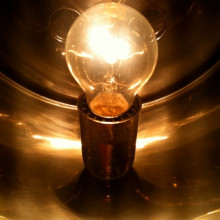
50:53 - When should I replace my CFL bulbs with LEDs?
When should I replace my CFL bulbs with LEDs?
Ricky Navthani took Philip's question to Andy Smale from the consultancy Energy Expert:
Andy - LED technology is now far superior to compact fluorescent designs. LED bulbs switch on instantly at full brightness, rather than taking a minute or two to warm up, and most LED bulbs now replicate the yellowish light of old filament bulbs very closely, whereas CFL bulbs can still sometimes have a slight pink or purple tinge. On the downside, a minority of LED bulbs have a high frequency flicker which bothers some people more than others.
Ricky - It looks like there’s not much competition between LEDs and CFLs. But would buying LED bulbs cost me more money than they’re worth?
Andy - The best LED bulbs use about half the energy of CFL bulbs for the same light output and are now claimed to last between 10 and 25 years with typical use. If you buy a pack of them, you can get them for about £2 each, so they will pay for themselves in savings over just 2.5 years if you are replacing a CFL, and within 4 months when replacing a filament bulb.
Ricky - OK, in just a few years the amount they’ll save me in energy costs more than makes up for it! But can I justify it on environmental grounds? What about the overall CO2 emissions?
Andy - Likewise, the carbon emissions resulting from manufacturing a new LED bulb are about 4kg of CO2 and recycling your old CFL bulb releases about 100g of CO2 or in the region of about 3kg if you drive 3 miles or so to your nearest recycling centre and back. So there’s a one off 7-8 kg CO2 cost in replacing the bulbs. But since LEDs release about 2 kg less CO2 a year, assuming average usage, in 4 years you’ll also have released less CO2 overall than if you hadn’t switched them at all. That saving is compounded if you replace all the bulbs in one go. As a result of these advantages, there is a strong economic and environmental argument for replacing all of your older energy-saving bulbs before they expire.
Ricky - This is looks like a no-brainer! Not only are LEDs cheaper in the long run, but they’re better for the environment too. Time to go throw all my old CFLs away!
Andy - CFL bulbs contain environmentally-hazardous mercury and other materials which can be recycled, so when they are swapped out they must only be disposed of in the special facilities available at most recycling centres.
Related Content
- Previous Can mosquitoes transmit HIV?
- Next Putting genomics to work










Comments
Add a comment